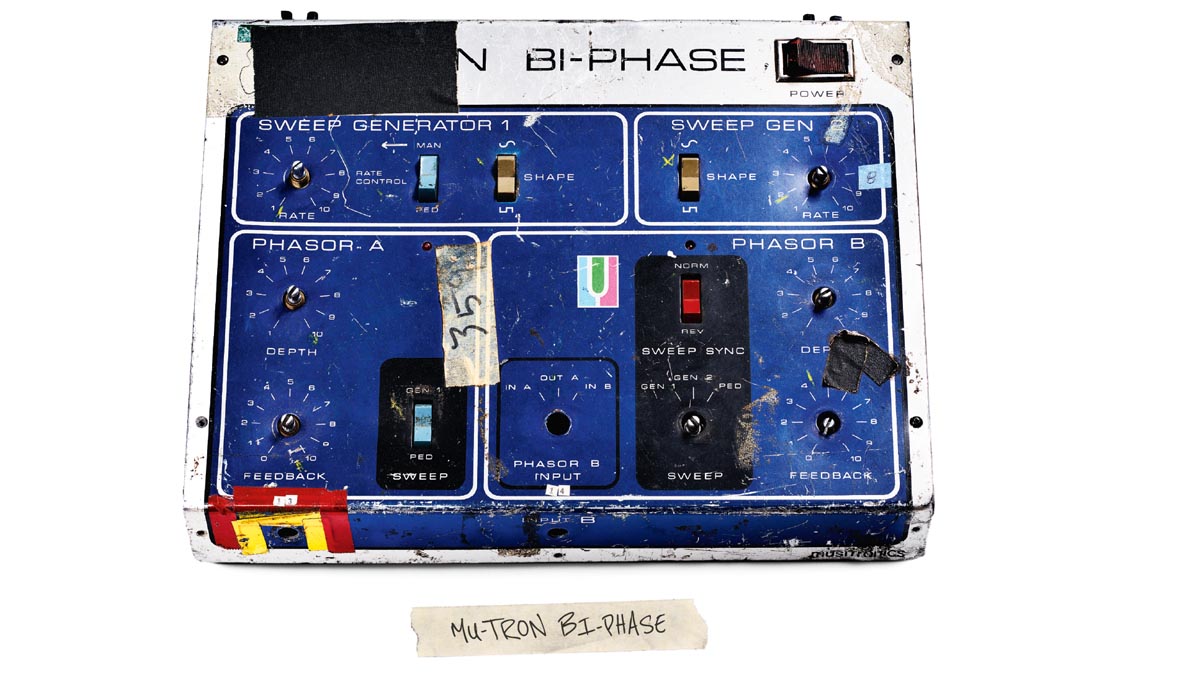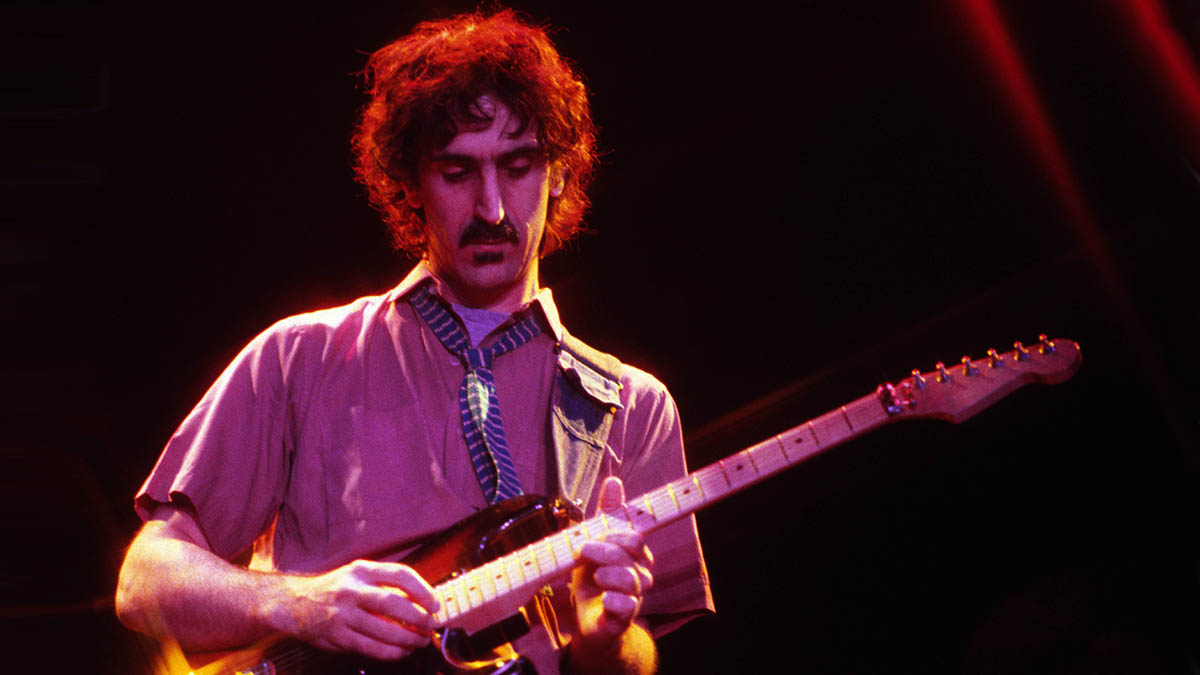The story of Frank Zappa and the Mu-Tron Bi-Phase
Eilon Paz and Dweezil Zappa unpacks the relationship between guitar's most maverick player and the ultimate phaser

“Stompbox: 100 Pedals Of The World’s Greatest Guitarists features the actual pedals owned and used by the artists themselves,” explains creator and photographer Eilon Paz. “The whole project took us about four years from start to finish and was very expensive to produce, but it was a process.
Introduced in 1972 by Musitronics, the Mu-Tron Bi-Phase is still regarded by many as the ultimate phaser, consisting of two independent lush-sounding six-stage phasers with independent Rate, Depth, and Feedback controls, LFO wave Shape and Sweep assignment switches, and stereo Input and Output jacks.
The two phasers can run in or out of sync with each other and be routed in series or parallel.
The pedal is powered by a hardwired 110-120-volt cord and utilises a 1 amp 3AG fuse. The Bi-Phase is controlled with a proprietary standalone dual footswitch or the Mu-Tron C-100 Opti-Pot Control Pedal.
“The success of my first book – Dust & Grooves: Adventures In Record Collecting – made me think about continuing to make music books that were visually intriguing. My priority was always to do something that hasn’t been done before and that interests me as a photographer.
“These old, beat-up pedals with strong, bold colours and designs just look incredible, but guitar pedals are a bit of a mystery to the wider audience and I wanted to open that door. I was aiming to make these books accessible and not just for pedal nerds. That’s why I wanted to include so many famous artists.
“There is a strong community behind this project – a collective – which is imperative to its success. It was crucial to get as many people involved as possible and build a strong team, while making each person an ambassador. I first reached out to Lee Ranaldo.
“I ambushed him after a show and gave him a copy of the Dust & Grooves book and he was immediately into it. Then, since I’m not a pedal expert, I looked for a team. Barry Cleveland was the first person onboard, and he brought in John Frusciante, then I managed to get Tom Morello and Vernon Reid. From there, more and more artists got involved and it really snowballed.
“Josh Scott [of JHS Pedals] connected us with a museum in Pennsylvania called EMEAPP – the Electronic Music Education and Preservation Project – in order to photograph the Jimi Hendrix Fuzz Face they own. When we went over there to look at their pedals, the owner told us, ‘We have Frank Zappa’s Mu-Tron Bi-Phase.’
“It took us a while to get more information on it and we were struggling for a while, but then Dweezil Zappa remembered it from his childhood. We actually wanted to do one of Dweezil’s pedals, but they weren’t available at the time, and so he gave us an interview about his dad instead…”
Get The Pick Newsletter
All the latest guitar news, interviews, lessons, reviews, deals and more, direct to your inbox!
Zappa on Zappa: Dweezil on his father and the Bi-Phase

“I remember seeing the Bi-Phase sitting around his studio,” says Dweezil Zappa, Frank Zappa’s eldest son and renowned keeper of his musical legacy. “It was a stock unit. Though it was pretty beat up – knobs missing and such – it wasn’t modified in any way.”
As early as 1973 (it’s visible on his pedalboard in the concert film Roxy: The Movie, which captures Zappa and the Mothers’ landmark three-night December ’73 stand at The Roxy in West Hollywood), this comb-filtering behemoth could be seen in front of Frank’s hybrid tube/solid-state rig.
“The Bi-Phase was used to enhance Frank’s direct, very clean and compressed sounds,” explains Dweezil. “A good example is I Promise Not To Come In Your Mouth [originally included on 1978’s Zappa In New York], which has a guitar solo where you hear the effect of the pedal clearly.”
Other noteworthy Zappa Bi-Phase moments can be heard on Penguin In Bondage from 1974’s Roxy & Elsewhere, and Pink Napkins from 1981’s Shut Up ’n Play Yer Guitar.
“Ultimately, the sound Frank produced with the Bi-Phase was thick and rich and had a ‘quack’ as a result of the way he set it,” says Dweezil. “It was more of an envelope-based phasing.” If you’ve ever seen Dweezil’s complex live rig and wondered where the impetus to build such a matrix of connections could originate, look no further than dear old dad.
What’s good about the Bi-Phase is its ability to sweep through a frequency range that’s never harsh, even at the extreme points of the modulation cycles
Dweezil Zappa
“Between ’75 and ’80, my dad developed a massive guitar rig he called ‘Ma Bell’,” Dweezil recalls. Pre-dating the rack shelves, MIDI and neatly packaged power supplies today’s players take for granted, Frank defied the era’s conventional approaches to live guitar setups by taking effects such as the Bi-Phase and his fabled Oberheim VCF-200 out of their casings and putting them in a system of slots much like a modern-day computer tower, where they were all connected to a main circuit board sporting a power supply.
“His typical guitar output was four or five channels,” Dweezil explains. “Two DIs and two or three amplifiers. The DIs were usually the ones that were affected by the Bi- Phase.
“What’s good about the Bi-Phase is its ability to sweep through a frequency range that’s never harsh, even at the extreme points of the modulation cycles. Unlike most phasers, there was something about the character of that sound that never wreaked havoc in Frank’s chain.”

Frank had a penchant for wreaking his own havoc, of course, creating unique tonalities with pedals like the Bi-Phase.
“My dad always wanted to have clean sounds with sustain and compression loud enough to be heard over the band,” Dweezil explains. “He ended up getting the sounds he wanted through preamps that were built into his guitars, which brought them up to line level – something as ridiculous as 50dB.
“This allowed him to better control the headroom of the studio effects like the dbx 160 Compressor/Limiter he was using in his guitar rig along with pedals. Since his guitar was at line level, anything he would do with a guitar amp barely required any preamp gain – it was all power amp. As a result, he had this massive sound with great sustain.”
The Bi-Phase sounded great in such an impressive sonic context, of course, but Frank also insisted that other members of his band – like guitarists Ike Willis and Ray White, and keyboardist George Duke – use it for their instruments, as well.
“My dad chose the effects other people used,” says Dweezil. “In other words, if you landed a gig with Frank Zappa and he was using a Mu-Tron Bi-Phase, so were you.“
- For more info about Stompbox: 100 Pedals Of The World’s Greatest Guitarists and Vintage & Rarities: 333 Cool, Crazy And Hard To Find Guitar Pedals visit Stompbox Book.
Rod Brakes is a music journalist with an expertise in guitars. Having spent many years at the coalface as a guitar dealer and tech, Rod's more recent work as a writer covering artists, industry pros and gear includes contributions for leading publications and websites such as Guitarist, Total Guitar, Guitar World, Guitar Player and MusicRadar in addition to specialist music books, blogs and social media. He is also a lifelong musician.
“The original Jordan Boss Tone was probably used by four out of five garage bands in the late ’60s”: Unpacking the gnarly magic of the Jordan Boss Tone – an actual guitar plug-in that delivers Dan Auerbach-approved fuzz
“This is a powerhouse of a stompbox that manages to keep things simple while offering endless inspiration”: Strymon EC-1 Single Head dTape Echo pedal review












